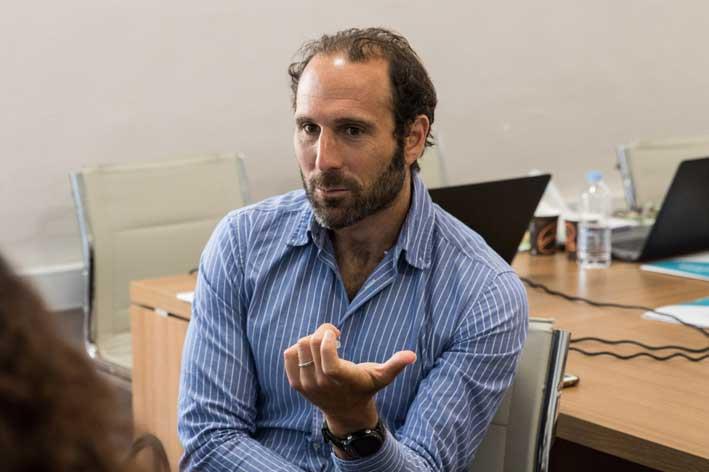Maltese parents have often been accused of wrapping their children in cotton wool, but Canadian psychiatrist and expert in adolescent mental health Dr Stan Kutcher says that overprotecting children can impair their ability to effectively cope with everyday stress later down the line. Dr Kutcher was recently a guest at the training programme ‘How not to Bubble Wrap Kids: Learning how to use daily stress to develop resilience’, organised by the Maltese Association of Psychiatry for teachers, child psychologists and counsellors, witht the aim of enhancing mental health literacy among both adolescents and teachers. An evidence-based mental health school curriculum guide has already been adopted by 13 countries, focusing on the human brain, mental disorders and how to distinguish between disorders and life challenges. The Malta Independent on Sunday was invited to speak to Dr Kutcher, along with consultant child and adolescent psychiatrist Dr Nigel Camilleri and psychiatry trainee Emma Saliba, to discuss how stress can be good for you, and how adolescents (and teachers) can benefit from learning about mental health literacy.
Could you tell us about the training programme?
Kutcher: What we are doing is bringing to Malta an educational mental health intervention that has been studied and applied in many countries around the world. It is highly effective for not only students, but also teachers, as it focuses on understanding mental health and mental health literacy.
Camilleri: Mental health literacy would include things like not using ‘anxiety’ or ‘depression’ to describe everything. For example, it is normal to experience stress before an exam; otherwise, it would not be a challenge. It is important not to bubble wrap kids, as people tend to work best when under pressure. A moderate level of stress, for instance, pushes students to pick up a book and study.

Stan Kutcher
Does the programme’s title reflect the situation in Malta?
Saliba: The idea is that we should not over protect our children, because this will impair their growth and development. One of the topics we discussed is how to distinguish mental distress from mental disorder. A certain level of stress can be helpful, challenging you to overcome obstacles and reach your full potential. Bubble wrapping children disrupts this sort of development.
How can one distinguish between good stress and that which is toxic?
Saliba: Stress is harmful when it leads to functional impairment; in other words, when it begins to interfere with daily activities. This could include somatic symptoms, changes in appetite, altered sleep patterns, as well as interpersonal issues.
Camilleri: Protecting children from stress impairs their ability to cope with everyday life, which is full of different stresses. If stress is prolonged, then it may develop into a mental disorder. Still, we should remember not use labels. For example, we should not say ‘This child has ADHD; we need to sort him out.’ It would be more helpful to say ‘This child struggles to sit still in class. Is there anyone who can help us with this?’
 Nigel Camilleri
Nigel Camilleri
Is labelling entrenched in our education system, and how does the training programme aim to reverse this?
Kutcher: Labels are for soup cans; diagnoses are for people. It is important to diagnose people with mental disorders, but it is also important not to misdiagnose those who are not suffering from any disorder. This programme is trying to teach teachers, parents and students to use the right words to describe what they see and not to jump to conclusions.
Is there a rise in young people claiming to have a mental disorder or suffering from extreme stress? If so, why do you think this is?
Saliba: We know that most mental disorders usually develop before the age of 25. The aim of this course is to identify them early. There are a number of reasons why stress has increased over time, such exams, applying for university, relationships, break-ups and childhood traumas. This can affect a child’s academic performance and relationships as well.
Kutcher: The prevalence of mental disorders has not changed over the past 40 years. What has changed in the last decade is the increase of self-reporting/self-identifying. As people start learning more about mental illness, they start questioning whether they also have one and seek help.
We also have a big problem with young people interpreting normal acute stress as ‘abnormal’. If they feel unhappy, they assume they have depression; if they feel nervous, it means they suffer from anxiety. So they seek help for normal feelings, and this causes huge problems as it leads them to believe they are unwell. It also increases the demand for health services, which are already limited, to the detriment of patients in genuine need of treatment. The poor and disadvantaged are hit the hardest by this.
Camilleri: Self-reported studies show that 25% of young people are depressed, but the reality is they do not meet the full criteria for depression. They might be feeling sad and low, but this is not clinical depression. So we need to be aware of the language we use. We also touch upon the notion of stigma in mental health illnesses.

Emma Saliba
How is the teaching of mental health literacy helping decrease the notion of mental health stigma?
Kutcher: One of the things that people are learning about is how to use a curriculum resource in schools and how to teach that resource. As part of that, young people and teachers are being taught to understand stigma and are being given the tools to decrease the stigma. The impact of this, shown from the research of other countries, is when young people and teachers are exposed, the stigma of mental health decreases and remains low. That is hugely positive. Once these adolescents grow up, they continue to carry this sense of understanding and, over time, we will see decreases in stigma. Teachers are extremely important people; they have an important place in the social hierarchy. Once they themselves become less stigmatised, we will see an impact on a wider level.
Do you believe that the education system is at fault when it comes to this inability to cope with stress?
Camilleri: I think that rather than a fault, we are all trying to improve our knowledge of mental health. The more we know, the more we can help and be effective. This is something cultural, and probably even international, where we assume that a child is anxious or depressed, which is probably not the case. I believe it is down to the language we are using, and that everything is connected.
Saliba: We should acknowledge that this training programme is also tied with the Ministry for Education. Taking on this curriculum is a very positive step forward.
What do you hope this conference will achieve?
Saliba: We hope that this mental health guide will be implemented as part of the school curriculum. We hope that students can better appreciate mental health and mental health disorders, reducing stigma.
Kutcher: The health and education sectors should work together more often. I feel that it is wonderful that the minister for education has direct knowledge and has expressed a great interest himself. When you receive that kind of interest and dedication, it increases the chances of success. It does not guarantee them, but increases them.